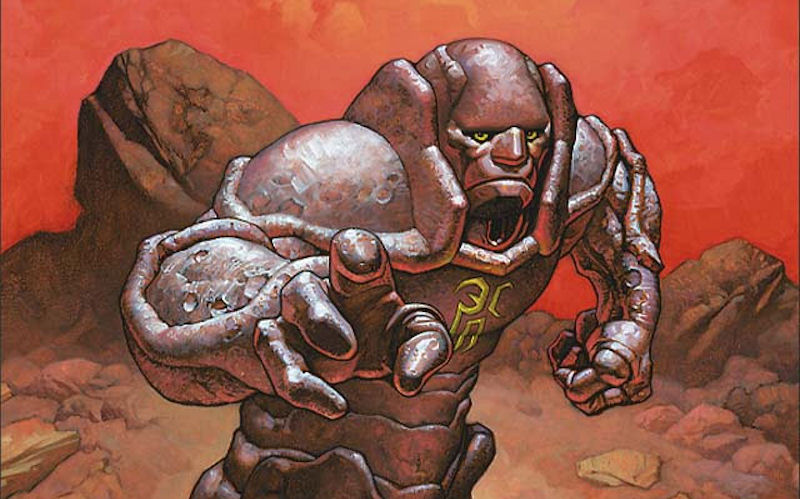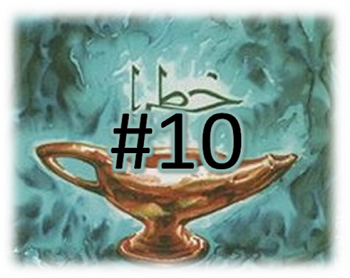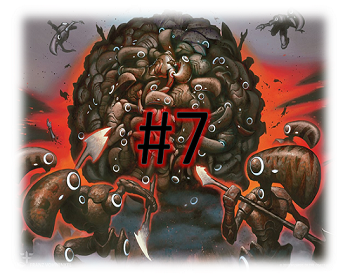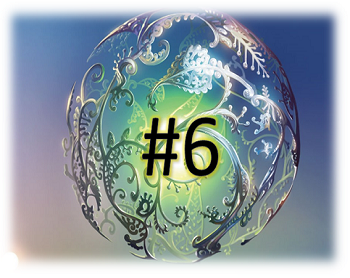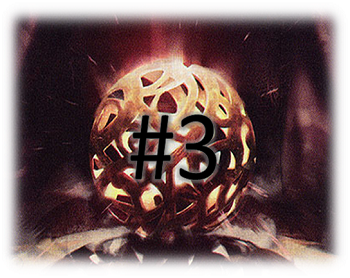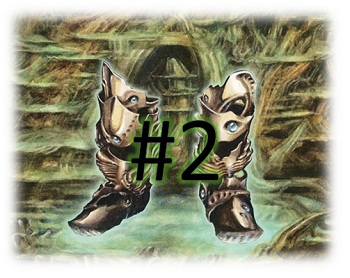(Karn, Silver GolemKarn, Silver Golem | Art by Mark Zug)
In With the Old?
Welcome to Too-Specific Top 10, where if there isn’t a category to rank our pet card at the top of, we’ll just make one up! (Did you know that Baron SengirBaron Sengir is the only card that can regenerate a Vampire specifically?)
In this day and age of Commander power creep, there is a lot of talk of creating an alternative version of the format to tamp things down a bit. One of the most popular examples given is to "ban all cards from sets that have never appeared in Standard". While I can appreciate this sentiment, especially given the number of completely busted commanders to come out of not only the Commander sets but also many of the supplemental sets like Modern Horizons, I would submit that this actually does nothing to solve the problem. And, appropriately enough, my evidence for why this is so can appear in the form of a top ten list:
Top 10 Non-"Supplemental" Commanders
- Muldrotha, the GravetideMuldrotha, the Gravetide
- Golos, Tireless PilgrimGolos, Tireless Pilgrim
- Korvold, Fae-Cursed KingKorvold, Fae-Cursed King
- Yarok, the DesecratedYarok, the Desecrated
- Niv-Mizzet, ParunNiv-Mizzet, Parun
- Gishath, Sun's AvatarGishath, Sun's Avatar
- Teysa KarlovTeysa Karlov
- Jodah, Archmage EternalJodah, Archmage Eternal
- Arcades, the StrategistArcades, the Strategist
- Feather, the RedeemedFeather, the Redeemed
If that looks like a friendly list for returning the format to the days of jank and variance, then remind me not to bring my battlecruiser deck to your table.
So, if we did have an interest in returning the format to its glory days, then we would have two options: either exhaustively research which sets were problematic as far as power creep in Commander and eliminate them one by one... or pick an arbitrary date out and roll with it.
Top 10 Commanders From Before 2000
Yeah, the turn of the millennia seems arbitrary enough that no one will question it.
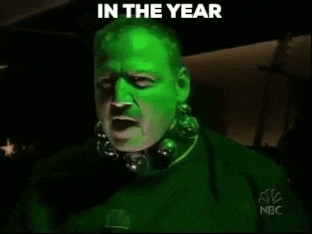
In all seriousness, power creep conversations existed in the year 2000, but they didn't seem to have as much merit at the time. We were right around the corner from Apocalypse and the spoiling of a card called SpiritmongerSpiritmonger that rocked the whole Magic universe... a five-mana 6/6? With upside? Not to be outdone, Odyssey block would bring us Devoted CaretakerDevoted Caretaker, which is not necessarily the first one-mana 1/2 with upside, but probably warrants more mention than Rime DryadRime Dryad, if we're being honest. A year later, Elvish WarriorElvish Warrior would make a splash and be drafted a bit too highly as the first vanilla two-mana 2/3.
Each of these examples may seem like small steps, and they are exactly that. What is more interesting about them, however, is that they each represent a break of what, until that point, was a hard barrier for mana-cost-to-power-and-toughness ratios. Not that there hadn't been cards with more power and toughness than mana cost previously, but other than the popular example of Savannah LionsSavannah Lions, they had, by and large, come with downsides stapled to them. These days, we have surpassed many more barriers on power level, although most of them are less blatant. Regardless, it is my opinion that the turn of the millennia also brought a desire on the part of R&D to push the envelope, a desire that has remained throughout the years.
With that in mind, let us draw our arbitrary line at the year 2000, and see which Commanders are the most played that were printed prior to that shift in power priorities!
Criteria: Legendary creatures printed prior to the year 2000, culminating in all sets from Alpha to Battle Royale (a box set immediately following the printing of Mercadian Masques). As is tradition, all results are ordered by EDHREC score.
10. Zirilan of the ClawZirilan of the Claw
(Helms 154 Decks, Rank #461)
Before there was The Ur-DragonThe Ur-Dragon, before there was Scion of the Ur-DragonScion of the Ur-Dragon, before even Bladewing the RisenBladewing the Risen, there was Zirilan of the ClawZirilan of the Claw. A sort of tribal-specific combination of Yisan, the Wanderer BardYisan, the Wanderer Bard and Sneak AttackSneak Attack, Zirilan lets you search your library each turn for a Dragon and put it directly on the battlefield. It gains haste and is then exiled at the end of the turn. That is, unless you were to find some way to get around that....
While there are definitely some more common commanders from the old days further down this list, I can't help but cheer for the sheer tenacity and inventiveness that Zirilan decks bring to the equation. Keep it up, Dragon fans... I'd pay money to be at more tables with decks like this that have me wondering what on earth is going to happen next, as opposed to sitting down versus yet another Muldrotha deck.
9. Dakkon BlackbladeDakkon Blackblade
(Helms 161 Decks, Rank #450)
On the one hand, there are 13,476 decks playing Blackblade ReforgedBlackblade Reforged. On the other hand, it is colorless and only costs two mana to cast. Dakkon BlackbladeDakkon Blackblade, on the other hand, costs six mana with an extreme color requirement. Still, you'll be happy to know that there are some endeavoring folk out there who have managed to put every Blackblade card into a Dakkon BlackbladeDakkon Blackblade.
In fact, there are enough of these Vorthos-completionist types that a 15% of Dakkon's 161 decks play a copy of each Blackblade card, and I, for one, celebrate their dedication. The decks may be jank, but you have to respect those that would stick to the dream, especially given that Korlash, Heir to BlackbladeKorlash, Heir to Blackblade is fairly awful in a three-color deck.
8. Hazezon TamarHazezon Tamar
(Helms 176 Decks, Rank #437)
Let's be clear: We all celebrate the fact that R&D has eliminated rules text like "On your next upkeep after Hazezon is put into play" from the game. That said, the sentence "put * token Sand Warriors into play, where * is the number of lands under your control" following that confusion-fest more than makes up for it. Sure, they're only 1/1s, and they get exiled if Hazezon TamarHazezon Tamar leaves the battlefield, but that's still a lot of go-wide available for anything from aggro to some bastardized version of Naya Aristocrats. And now upon hearing the phrase "Naya Aristocrats" I immediately want to brew. Maybe there's a reason old Hazezon is in this top ten...
7. Angus MackenzieAngus Mackenzie
(Helms 233 Decks, Rank #382)
I've been fairly critical of Muldrotha, the GravetideMuldrotha, the Gravetide in this article, but let's be honest, Muldrotha can take it. That said, if you've ever played against a deck that can recur Spore FrogSpore Frog every turn, or that can afford to keep paying the Buyback on Constant MistsConstant Mists, then you know the kind of havoc these repeatable FogFogs can wreak on a Battlecruiser table.
Well, there's good news! If you have a free $200 sitting around, you can have that repeatable FogFog in the command zone, courtesy of Angus MackenzieAngus Mackenzie! Just keep in mind, there are other ways to win than combat damage....
6. Selenia, Dark AngelSelenia, Dark Angel
(Helms 241 Decks, Rank #374)
When Selenia, Dark AngelSelenia, Dark Angel was first printed, Commander was a twinkle in Sheldon Menery's local playgroup's eye, and Axis of MortalityAxis of Mortality wasn't even a thought that had occurred to Magic's designers. Despite this, the mundane Fleeting ImageFleeting Image ability, and the sub-par body for the mana cost, Selenia has proved to have staying power in the Commander format. The reason, as with so many things when it comes to old Commander cards, is that the engineered drawback of the card has been found to be exploitable in a fashion that will make it an advantage. In this case, you can stack Selenia's "Pay 2 life" ability as many times as you like before she actually returns to your hand, allowing you to bring your life total down from 40 to 2 in a heartbeat. While that may not sound like the best place to be in a game of Commander, if you do manage to do so at no mana cost, you can easily follow up that life loss with any number of cards that interact with life totals to your advantage and your opponents' loss.
Repay in KindRepay in Kind allows you to bring yourself and everyone else down to 1 life, at which point something as mundane as Vicious RumorsVicious Rumors could win you the game. Near-Death ExperienceNear-Death Experience and TriskaidekaphobiaTriskaidekaphobia don't even require that much effort, allowing you to win the game by just having the correct life total. However you decide to manipulate the lives of those around you, having a means in the command zone to take off huge points of your life total is absolutely invaluable, as does never really having to pay Commander tax.
5. Sliver QueenSliver Queen
(Helms 252 Decks, Rank #366)
Sliver QueenSliver Queen's might among the Sliver tribe has mostly been surmounted by the likes of Sliver OverlordSliver Overlord and The First SliverThe First Sliver. If you've ever played against the Sliver QueenSliver Queen variants, however, you might be aware that the ability to make a 1/1 Sliver at the cost of a mere two colorless mana is absolutely dominating. Far from being the "fair" version of the Sliver deck you might see out of the tutor-on-a-stick Sliver OverlordSliver Overlord or the "acquire variant value until a win shows up" The First SliverThe First Sliver, Sliver QueenSliver Queen comes with a plan stapled on that can go infinite at almost any time.
You can immediately get infinite ETB/death triggers with Basal SliverBasal Sliver or Ashnod's AltarAshnod's Altar. Add in a HeartstoneHeartstone and you can have infinite mana as well. As for ways to pay off those infinite triggers, just within the tribe itself there's Lavabelly SliverLavabelly Sliver, with any number of other versions if you look at the broader world of Slivers in all five colors.
4. Karn, Silver GolemKarn, Silver Golem
(Helms 261 Decks, Rank #355)
As mentioned in my Top 10 Reserved List Cards Under Ten Dollars article, Karn, Silver GolemKarn, Silver Golem was the go-to colorless commander for much of Magic's history, and that has created some staying power despite the newer additions. His resilience in combat has helped with that somewhat, but the real shining star here is his ability to pay a single mana to bring artifacts to life. This allows for both straightforward shenanigans like swinging in with a Mycosynth GolemMycosynth Golem for 11, to the much more inventive shenanigans like making everyone's permanents into artifacts with Mycosynth LatticeMycosynth Lattice and then destroying just the "creatures" your opponents control with a board wipe.
3. Rubinia SoulsingerRubinia Soulsinger
(Helms 301 Decks, Rank #317)
Theft decks have been a thing in Commander since time immemorial, and Rubinia SoulsingerRubinia Soulsinger has been at the forefront of it. While a fairly mundane Control MagicControl Magic in the command zone much of the time, the ability to tap and then untap Rubinia repeatedly while her ability remains on the stack has proven to be a powerful tool. This allows you to claim not one, but several creatures, depending on how many times you can untap this little Faerie at instant speed. You may feel like that's a lot of setup for a fairly mundane effect, but I can tell you from experience that people will jump through a lot of hoops when it comes to stealing your stuff. It's an enjoyable strategy on the whole, and also lets people feel as if they're adhering to the 75% mindset by matching power levels, as they're "only playing at the level you're bringing to the table."
2. Nicol BolasNicol Bolas
(Helms 339 Decks, Rank #288)
Far and away the most powerful and popular of the original Elder Dragon Legends that the format is named after, Nicol BolasNicol Bolas is still a halfway decent commander today on his damage ability alone. For those that haven't had the chance to face it, it is extremely notable that said ability says "damage", not "combat damage", and as such, effects like Viridian LongbowViridian Longbow and Chandra's IgnitionChandra's Ignition can be absolutely devastating. While that may not be worth the eight mana right off the bat, it is nonetheless an effect that nostalgic and hipster players have held on to over the years, even with the additional upkeep cost that all of the original Elder Dragons had.
There was absolutely a reason that Nicol BolasNicol Bolas specifically became the big baddie of the Magic: The Gathering storyline over the years, and it's the popularity that the original version had, from functionality that far surpassed the others in the cycle to the goofy Edward Beard masterpiece of this giant Dragon casually reading a book in his skull-chair.
1. PhelddagrifPhelddagrif
(Helms 605 Decks, Rank #187)
Long-time readers will know that I'm a bit of a PhelddagrifPhelddagrif fan, myself, and how could you not be? This may be the most unique artwork in all of Magic: The Gathering, pasted onto a box of rules text that barely makes sense anymore in a world where a four-mana 4/4 is the norm, rather than an abnormality that was considered above-rate back in Alliances. As it is, swinging in for four is rarely in the cards for our dear winged Hippo, and it's all the better and cuter for it. Instead, Group Hug is now the name of the game for PhelddagrifPhelddagrif, and has been for quite some time. While there are some elements that instead use the purple Hippo to make a large number of Hippos for their enemies and cost them life via Suture PriestSuture Priest while doing so, the majority of folks are instead using the Hippo for politics, promising Hippos as a trade for non-aggression and keeping the mana-screwed player in the game with life-gain so that there's more chance for complications down the road. All in all, however, probably one of the main reasons for PhelddagrifPhelddagrif's staying power is the unique idea and artwork to match, and, again, who can really blame people for wanting to have a game that goes a bit differently with a smiling purple Hippo to go with it?
Honorable Mentions
While this has been a fun exercise, I firmly believe that any indulgence in nostalgia is ultimately doomed to fail. Only allowing Commanders from before the year 2000 would definitely be so, as, outside of a few examples, what you would ultimately get would be a format in which no one casts their commander. If you moved it out to include only cards from before the year 2000, you'd probably have an interesting niche format, but I sincerely don't believe it would have any staying power whatsoever, especially once card prices spiked to incredible levels as people tried to find old cards.
With all that said, however, let us perform one more thought experiment in this vein, and find the most popular commanders from before the printing of the original Commander precons--the time period before Wizards ever really started designing around the format.
Top 10 Commanders From Before Commander
- Zur the EnchanterZur the Enchanter Helms 2238 Decks, Rank #24
- Sliver OverlordSliver Overlord Helms 1467 Decks, Rank #60
- Ezuri, Renegade LeaderEzuri, Renegade Leader Helms 1175 Decks, Rank #90
- Sen TripletsSen Triplets Helms 1099 Decks, Rank #97
- Reaper KingReaper King Helms 1011 Decks, Rank #103
- Rhys, the RedeemedRhys, the Redeemed Helms 956 Decks, Rank #106
- Grand Arbiter Augustin IVGrand Arbiter Augustin IV Helms 928 Decks, Rank #109
- Mayael the AnimaMayael the Anima Helms 921 Decks, Rank #110
- Omnath, Locus of ManaOmnath, Locus of Mana Helms 861 Decks, Rank #121
- Oona, Queen of the FaeOona, Queen of the Fae Helms 812 Decks, Rank #129
Overall, this seems to be a much broader list that would restrict power quite a bit to keep things like the good ole days. With that said... It also includes quite a few powerful commanders that people dislike, from Zur the EnchanterZur the Enchanter to Grand Arbiter Augustin IVGrand Arbiter Augustin IV. While it would be interesting to play around with some sort of "Historic" Commander (although we'd have to think of a new name), I'm still just not seeing any scenario where it becomes more than a fun build challenge for your playgroup/Local Gaming Store before everyone then returns to playing "real" Commander.
What Do You Think?
Overall, there are a lot of ideas out in the world on how to improve Commander as a format. While I personally had pinned my hopes on Brawl and Historic Brawl as a means to slow the format down a bit, they instead became another competitive one-versus-one format, and as such I am honestly hoping that we find some kind of variant for those of us that prefer games to go at more of a battlecruiser clip. Regardless of my personal feelings, however, what do you think of these ideas? Are they serious? Is Commander where you'd like it to be? Are you worried about the never-ending power creep, or would you like to see where things are headed?
Take Our PollAnd finally, what are your favorite old commanders? Are there some Tempest and Legends legendaries that you just can't let go of?
Let us know in the comments, and we'll see you at the rickety old table in the back with the scuff marks all over it.
DougY
Doug has been an avid Magic player since Fallen Empires, when his older brother traded him some epic blue Homarids for all of his Islands. As for Commander, he's been playing since 2010, when he started off by making a two-player oriented G/R Land Destruction deck. Nailed it. In his spare time when he's not playing Magic, writing about Magic or doing his day job, he runs a YouTube channel or two, keeps up a College Football Computer Poll, and is attempting to gif every scene of the Star Wars prequels.
Your opinions are welcome. We love hearing what you think about Magic! We ask that you are always respectful when commenting. Please keep in mind how your comments could be interpreted by others. Personal attacks on our writers or other commenters will not be tolerated. Your comments may be removed if your language could be interpreted as aggressive or disrespectful. You may also be banned from writing further comments.
